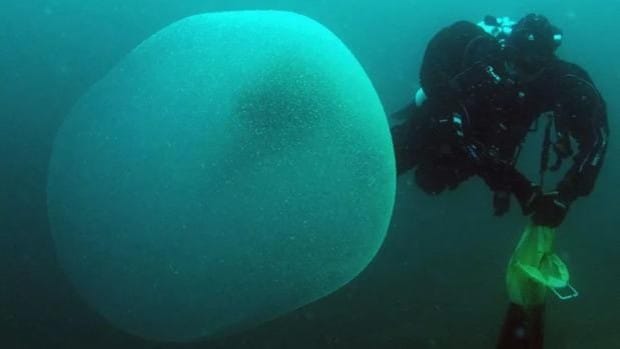 For more than three decades, divers have encountered almost a hundred enormous gelatinous spheres that scientists have not yet been able to explain. Now, thanks to citizen collaboration and DNA, it has been possible to unravel the mystery: these are egg sacs from a marine mollusk called
For more than three decades, divers have encountered almost a hundred enormous gelatinous spheres that scientists have not yet been able to explain. Now, thanks to citizen collaboration and DNA, it has been possible to unravel the mystery: these are egg sacs from a marine mollusk called
Illex coindetii
(popularly known as pota or lula in Spain). The results have just been published in the journal 'Scientific Reports'.
Found both in the Mediterranean Sea and on the coasts around Norway, these 'droplets' of more than a meter in diameter were always found floating between the seabed and the surface. They are more or less translucent masses, with a dark stripe running through their center. But little else could be guessed about its interior, which has been eluding all classifications for years. Some researchers suggested that perhaps these spheres were egg masses.
Ommastrephid
, very similar to squid. But without DNA analysis of the tissue there was no way to show which exact species had created them.
It was a couple of years ago when Halldis Ringvold, manager of the marine zoology organization Sea Snack Norway, launched a citizen science campaign that encouraged divers to collect small tissue samples from any slicks they found in the waters near Norway. In 2019, divers obtained tissue samples from four different spots, which they collected in small plastic bottles and stored in home refrigerators (tissue collection did not appear to harm the egg masses in any way, according to the study).
This is how the analyzes revealed that these were bags with hundreds of thousands of eggs of I. coindetii, a species that has been known for more than 180 years and is present throughout the Mediterranean and on both sides of the Atlantic, although it has never been They had identified these egg sacs in the wild. Known as southern shortfin squid, also called squid in Spain, it is a ten-tentacled cephalopod that lives on both sides of the Atlantic Ocean. They are carnivorous and very voracious, since they have very accelerated growth, since they generally live one year, and die after spawning. Thus, this sphere would be of the same type, although much larger than the previous ones found, which were barely close to a meter in diameter.
"We were also able to see what's inside the sphere, showing squid embryos at four different stages," Ringvold explains. "In addition, we were able to follow how the sphere actually changes consistency, from firm and transparent to ruptured and opaque, as the embryos develop."
Additional photos of the spots, spotted near Norway, Sweden and England
–
Ringvold, H., Taite, M., Allcock, A.L. et al.
I. coindetii belongs, indeed, to the group of Ommastrephidae. During reproduction, females produce large egg spheres made of a gelatinous substance that they make themselves to keep their embryos floating safe from predators. However, sightings of these masses are rare and have never been seen in the wild before.
What is the strange line that crosses the spheres?
As for the strange, dark band that crosses the spheres, researchers suspect that it is a river of ink that the females expel when fertilizing their eggs. "The spheres with or without ink can indicate the degree of maturity of the embryos," say the researchers. Thus, those with a more accentuated stripe are the most recently created. "After a while, when the eggs begin to develop, the entire sphere, including the vein, will begin to disintegrate." In addition, the team suggests that it could also be a kind of camouflage mechanism intended to imitate large fish and thus scare away possible predators.
But, despite the results obtained, the mystery still continues: scientists point out that they cannot be completely sure that the hundred spots observed since 1985 all belong to the same species. Although they point out that since they are very similar in shape and size, "it is very likely that many of them were created by I. coindetii."
